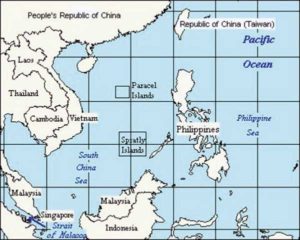Chips
We are a chip based society. Chips are tiny pieces of silicon with intricate circuits on them and they are the lifeblood of today’s economy. These clever semiconductors make our internet-connected world go round. In addition to iPhones and PlayStations, they underpin key national infrastructure and sophisticated weaponry. Chips are a foundational aspect of the future of artificial intelligence.
Semiconductors made from silicon wafers mounted with billions of microscopic transistors are the basic component of modern digital life and the building blocks of innovation for the future. They are arguably one of the world’s most important industries.
Controlling advanced chip manufacturing in the 21st century may well prove to be like controlling the oil supply in the 20th. The country that controls this manufacturing can throttle the military and economic power of others.
Chip Production
There are two types of semiconductor manufacturing companies in the chip industry. Some (like Intel, Samsung, SK Hynix, and Micron) design and make their own products in factories that they own. There are also foundries, which fabricate chips designed by consumer and military customers.
In sheer manufacturing capacity, Taiwan is number one followed by South Korea and U.S. in third place, with China gaining quickly. World’s top two chip companies are Taiwan Semiconductor Manufacturing Company (TSMC) of Taiwan and Samsung Electronics of South Korea.
The chips that TSMC makes are found in almost everything: smartphones, high-performance computing platforms, PCs, tablets, servers, base stations, game consoles, internet-connected devices like smart wearables, digital consumer electronics, cars, and almost every weapon system built in the 21st century. About 60 percent of the chips TSMC makes are for American companies.
Shortage. The severity of the global chip shortage has gone up a notch in recent times. The shortage is likely to last to last till 2022 or possible 2023. The reasons for the ongoing global chip shortage are complex and multifaceted.
Chip Wars
This was sort of expected. As the U.S.-China confrontation takes root, the ability to craft chips for everything from artificial intelligence and data centers to autonomous cars and smartphones has become an issue of national security, injecting government into business decisions over where to manufacture chips and to whom to sell them.
USA. A global semiconductor shortage and tensions with China have bolstered U.S. scrutiny of the supply chain and created a drive for it to regain leadership. The United States recently attacked China in trade war, by limiting Huawei’s ability to outsource its in-house chip designs for manufacture by Taiwan Semiconductor Manufacturing Company (TSMC), a Taiwanese chip foundry.
China. China uses 61 percent of the world’s chips in products for both its domestic and export markets. China recognized that its inability to manufacture the most advanced chips was a strategic Achilles heel. China devised two plans to solve these problems. The first one being made in China 2025 plan of the country’s roadmap to update China’s manufacturing base from making low-tech products to rapidly developing ten high-tech industries, including electric cars, next-generation computing, telecommunications, robotics, artificial intelligence, and advanced chips. China’s second plan is the National Integrated Circuit Plan, a roadmap for building an indigenous semiconductor industry and accelerating chip manufacturing. The goal is to meet its local chip demand by 2030.
Taiwan. TSMC of Taiwan has established a R&D team to find a feasible path for development of semiconductors below 1-nanometer (nm). TSMC will also be expanding capacity as in places like Japan. About 20 Japanese companies, will work with Taiwan Semiconductor Manufacturing Co (TSMC) to develop chip manufacturing technology in Japan.
South Korea. South Korea’s strategy in the future of chips is more impressive than the U.S. Through the so-called “K-Semiconductor Strategy,” the South Korean government said it will support the industry by offering tax breaks, finance, and infrastructure. South Korea has a commanding lead in memory chips with a 65% share, largely thanks to Samsung. South Korea’s investment is being led by two of its biggest chip firms: Samsung Electronics and SK Hynix. Samsung Electronics meanwhile is planning to invest 171 trillion won through 2030, raising its previous investment target of 133 trillion won, which was announced in 2019.
Future
Scientists have for a long time looked towards the potential of thin two-dimensional semiconductors in realizing high-performance electronic devices. However, there have been two significant problems to migrating semiconductor production to use this new tech. Firstly the materials had an inherent property of high contact resistance, and secondly they had poor current delivery capabilities. These issues seem to have been resolved. These are exciting times in the future of technology. Advances in chip technology and quantum computing would determine how global innovation moves forward.
There is much more to it than meets the eye: more coming up soon
value additions and comments are most welcome
For regular updates please register here –
https://55nda.com/blogs/anil-khosla/subscribe/
References
1. https://warontherocks.com/2020/06/the-chip-wars-of-the-21st-century/
2.http://www.obela.org/system/files/The_importance_of_chips_in_commercial_warfare.pdf
3. https://www.scmp.com/economy/china-economy/article/3102518/us-china-tech-war-battle-over-semiconductors-taiwan-stokes
4. https://theprint.in/world/why-the-us-china-conflict-over-chips-is-about-to-get-even-uglier/529373/

